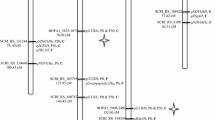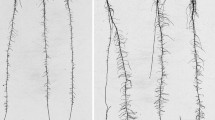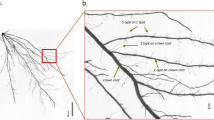Abstract
Low phosphorus availability is a primary constraint for plant growth in terrestrial ecosystems. Lateral root initiation and elongation may play an important role in the uptake of immobile nutrients such as phosphorus by increasing soil exploration and phosphorus acquisition. The objective of this study was to identify quantitative trait loci (QTLs) controlling lateral root length (LRL), number (LRN), and plasticity of the primary seedling root of maize under varying phosphorus availability. Using a cigar roll culture in a controlled environment, we evaluated primary root LRL and LRN at low and high phosphorus availability in 160 recombinant inbred lines (RILs) derived from a cross between maize genotypes B73 and Mo17, which have contrasting adaptation to low phosphorus availability in the field. Low phosphorus availability increased LRL by 19% in Mo17, the phosphorus-efficient parent, but significantly decreased LRL in B73, the phosphorus-inefficient genotype. Substantial genetic variation and transgressive segregation for LRL and LRN existed in the population. The plasticity of LRL ranged from −100% to 146.3%, with a mean of 30.4%, and the plasticity of LRN ranged from −82.2% to 164.1%, with a mean of 18.5%. On the basis of composite interval mapping with a LOD threshold of 3.27, one QTL was associated with LRN plasticity, five QTLs were associated with LRL and one QTL was associated with LRN under high fertility. Under low fertility, six QTLs were associated with LRL and one QTL with LRN. No QTLs were detected for plasticity of LRL. A number of RILs exceeded Mo17, the phosphorus-efficient parent, for LRL, LRN, and plasticity. The detection of QTLs for these traits, in combination with the observation of transgressive segregants in our population, indicates that favorable alleles can be combined to increase seedling lateral root growth in maize.







Similar content being viewed by others
References
Anonymous (1887) Report of the Pennsylvania State College Agricultural Experimental Station. Official Document Number 13
Barber SA (1995) Soil nutrient bioavailability: a mechanistic approach. Wiley, New York
Cathcart HB (1980) The phosphate industry of the United States. In: Khasawneh FE, Sample EC, Kamprath EJ (eds) The role of phosphorus in agriculture. American Society of Agronomy, Madison, pp 19–42
CIAT (Centro Internacional de Agricultura Tropical) (1999) Bean project: annual report. Cali, Colombia
Council NNR (1989) Alternative agriculture. National Academy Press, Washington D.C.
Da Silva AE, Gabelman WH (1993) Screening maize inbred lines for tolerance to low -P stress conditions. In: Randall PJ, Delhaize E, Richards RA, Minns R (eds) Genetic aspects of plant mineral nutrition. Kluwer, Dordrecht, pp 233–239
Da Silva AE, Gabelman WH, Coors JG (1992) Inheritance of low-P tolerance in maize grown in a sand–alumina culture medium. Plant Soil 146:189–197
Francis CA (1990) Sustainable agriculture: myths and realities. J Sustain Agric 1:97–106
Gaume A, Mächler F, Leon CD, Narro L, Frossard E (2001) Low phosphorus tolerance by maize genotypes: significance of root growth, and organic acids and acid phosphate root exudation. Plant Soil 228:253–264
He W (1962a) Sudies of the root incense cedar, Libocedrus decurrens. I. The origin and development of primary tissues. Am J Bot 49:221–236
He W (1962b) Growth studies of the root incense cedar, Libocedrus decurrens. II. Morphological features of the root system and growth behavior. Am J Bot 49:227–245
He W (1968) Morphological studies of the root of red pine. Am J Bot 55:247–254
Johnson JF, Vance CP (1996) Phosphorus deficiency in Lupinus albus. Altered lateral root development and enhanced expression of phosphoenolpyruvate carboxylase. Plant Physiol 112:31–41
Johnson JF, Allan DL, Vance CP, Weiblen G (1996) Root carbon dioxide fixation by phosphorus-deficient Lupinus albus: contribution to organic acid exudation by proteoid roots. Plant Physiol 112:19–30
Kaeppler SM, Parke JL, Mueller SM, Senior L, Stuber C, Tracy WF (2000) Variation among maize inbred lines and detection of quantitative trait loci for growth at low P and responsiveness to arbuscular mycorrhizal fungi. Crop Sci 40:358–364
Lynch JP (1995) Root architecture and plant productivity. Plant Physiol 109:7–13
Lynch JP (1998) The role of nutrient efficient crops in modern agriculture. J Crop Production 1:241–264
Lynch JP, Beebe SE (1995) Adaptation of beans to low soil phosphorus availability. HortScience 30:1165–1171
Lynch JP, Brown KM (2001) Topsoil foraging—an architectural adaptation to low phosphorus availability. Plant Soil 237:225–237
Lynch JP, Deikman J (1998) Phosphorus in plant biology: regulatory roles in molecular, cellular, organismic, and ecosystem processes. Current topics in plant physiology, vol 19. American Society of Plant Physiologists, Rockville, Md.
Lynch JP, van Beem JJ (1993) Growth and architecture of seedling roots of common bean genotypes. Crop Sci 33:1253–1257
Lynch JP, Epstein E, Lauchli A, Weigt GE (1990) An automated greenhouse sand culture system suitable for studies of P nutrition. Plant Cell Environ 13:547–554
Macleod RD, Thompson A (1979) Development of lateral root primordia in Vicia faba, Pisum sativum, Zea mays and Phaseolus vulgaris: rates of primordium formation and cell doubling times. Ann Bot 44:435–449
Naismith RW, Johnson MW, Thomas WI (1974) Genetic control of relative calcium, phosphorus, and manganese accululation on chromosome 9 in maize. Crop Sci 14:845–849
Netzer W (1987) Phosphate solubilizing genes might revolutionize fertilizer technology. Genet Eng Newsl 7:41
Reiter RS, Coors JG, Sussman MR, Gabelman WH (1991) Genetic analysis of tolerance to low-P stress in maize using restriction fragment length polymorphisms. Theor Appl Genet 85:561–568
Rundel PW, Nobel PS (1991) Structure and function in desert root systems. In: Atkinson D (ed) Plant root growth: an ecological perspective, Special Publication Number 10 of the British Ecological Society. Blackwell Scientific, Oxford UK, pp 349–378
Sample EC, Soper RJ, Racz GJ (1980) Reactions of phosphate fertilizers in soils. In: Khasawneh FE, Sample EC, Kamprath EJ (eds) The role of P in agriculture. American Society of Agronomy, Madison, pp 263–310
Senior ML, Chin ECL, Lee M, Smith JSC, Stuber CW (1996) Simple sequence repeat markers developed from maize sequences found in Genbank database: map construction. Crop Sci 36:1676–1683
Tuberosa R, Salvi S, Sanguineti MC, Landi P, Maccaferri M, Conti S (2002) Mapping QTLs regulating morpho-physiological traits and yield: case studies, shortcomings and perspectives in drought-stressed maize. Ann Bot 89:941–963
Utz HF, Melchinger AE (1999) PlabQTL: a program for composite interval mapping of QTL. J Quant Trait Loci 2:1 (http://www.ncgr.org/research/jag/)
Zhu J (2003) Composite interval mapping and physiological efficiency of root traits conferring phosphorus efficiency in maize (Zea mays L.). PhD thesis, Pennsylvania State University, University Park, Pa.
Zhu J, Lynch JP (2004) The contribution of lateral rooting to phosphorus acquisition efficiency in maize (Zea mays L.) seedlings. Funct Plant Biol 31:949–958
Zhu J, Kaeppler SM, Lynch JP (2005) Mapping of QTL controlling root hair length in maize (Zea mays L.) under phosphorus deficiency. Plant Soil 270:299–310
Zobel R (1986) Rhizogenetics (root genetics) of vegetable crops. HortScience 21:956–959
Zobel R (1996) Genetic control of root systems. In: Waisel Y, Eshel A, Kafkafi U (eds) Plant roots: the hidden half, 2nd edn. Marcel Dekker, New York, pp 21–30
Acknowledgements
We thank Dr. Richard Craig for his helpful discussion on the experimental design and statistical analysis. This research was supported by USDA-NRI grant 00353009246 to Shawn M. Kaeppler and Jonathan P. Lynch.
Author information
Authors and Affiliations
Corresponding author
Additional information
Communicated by D. Hoisington
Rights and permissions
About this article
Cite this article
Zhu, J., Kaeppler, S.M. & Lynch, J.P. Mapping of QTLs for lateral root branching and length in maize (Zea mays L.) under differential phosphorus supply. Theor Appl Genet 111, 688–695 (2005). https://doi.org/10.1007/s00122-005-2051-3
Received:
Accepted:
Published:
Issue Date:
DOI: https://doi.org/10.1007/s00122-005-2051-3




